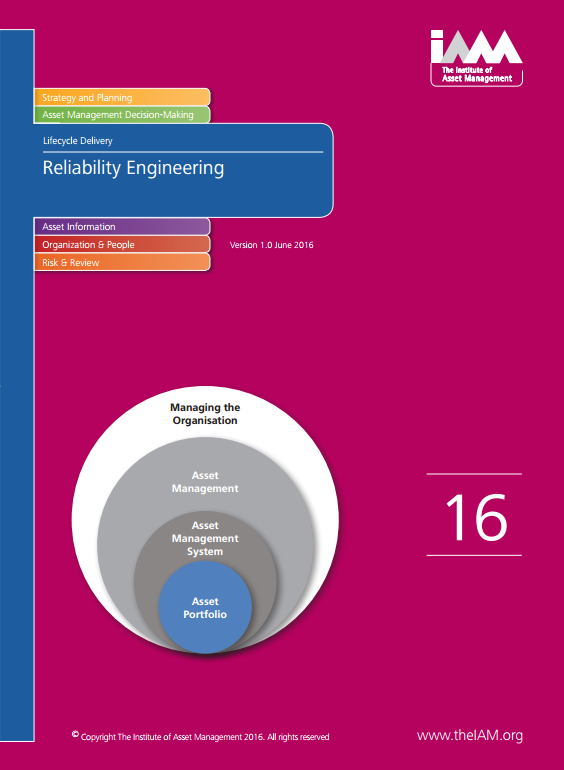Subject 16: Reliability Engineering
Version 1.0 June 2016
The Reliability Engineering SSG is based on the assumption that most people who read this SSG will be people who have existing assets and are looking at better ways to manage the reliability associated with them. For this reason this SSG focuses on the “in service” phase of the asset lifecycle. In applying this SSG, the reader is requested to view Reliability Engineering as a toolbox - some tools are used more often than others and some tools are more general whereas others have very specific applications. Given the assumption that most use of the SSG will probably be in the “in service” stage and be related to mostly physical asset management this SSG describes the applicability of techniques to be used for these purposes.
Reliability Engineering is a broad topic that covers many areas and techniques. These components of Reliability Engineering, one of which is Root Cause Analysis (RCA), are treated separately in this SSG so as to differentiate the value that they each offer.
To provide additional context this SSG provides case study examples from different sectors to demonstrate the key points of guidance.
With thanks to our sponsors of this publication.
| CONTENTS | |
|---|---|
| Preface | 2 |
| 1 INTRODUCTION TO SUBJECT SPECIFIC GUIDELINES 1.1 Purpose of the SSGs 1.2 The SSGs in context 1.3 SSGs and the issue of Complexity versus Maturity 1.4 Further reading |
6 |
| 2 INTRODUCTION 2.1 The Purpose, Intended Use, and Intended Audience of this SSG 2.2 Aligning this Document 2.3 Complexity versus Maturity 2.4 Navigating & Using this document |
8 |
| 3 WHAT DOES RELIABILITY ENGINEERING MEAN? 3.1 High Level Definition of the SSG Topic Area 3.2 SSG Approach to Reliability Engineering 3.3 Terminology |
12 |
| 4 CONCEPTS, PRINCIPLES AND KEY FACTORS 4.1 Concepts 4.2 Principles 4.3 Key Factors for Reliability Engineering |
18 |
| 5 RELIABILITY ENGINEERING TOOLBOX 5.1 Selecting the Right Tool for the Right Job 5.2 Mathematical Modelling 5.3 Reliability Engineering Tool Selection Matrix 5.4 FMEA/FMECA 5.4.1 What is it? 5.4.2 When is it used? 5.4.3 Complimentary techniques 5.4.4 Example procedure steps 5.4.5 Prerequisites 5.4.6 Typical Proprietary Tools 5.4.7 Objectives 5.4.8 Derived Benefits 5.4.9 References 5.5 FTA 5.5.1 What is it? 5.5.2 When is it used? 5.5.3 Complimentary techniques 5.5.4 Example procedure steps 5.5.5 Prerequisites 5.5.6 Typical Proprietary Tools 5.5.7 Objectives 5.5.8 Derived Benefits 5.5.9 References 5.6 HAZOP 5.6.1 What is it? 5.6.2 Limitations 5.6.3 When is it used? 5.6.4 Complimentary techniques 5.6.5 Example procedure steps 5.6.6 Prerequisites 5.6.7 Typical Proprietary Tools 5.6.8 Objectives 5.6.9 Derived Benefits 5.6.10 References 5.7 ETA 5.7.1 What is it? 5.7.2 When is it used? 5.7.3 Complimentary techniques 5.7.4 Example procedure steps 5.7.5 Prerequisites 5.7.6 Typical Proprietary Tools 5.7.7 Objectives 5.7.8 Derived Benefits 5.7.9 References 5.8 RCM 5.8.1 What is it? 5.8.2 When is it used? 5.8.3 Complimentary techniques 5.8.4 Example procedure steps 5.8.5 Prerequisites 5.8.6 Typical Proprietary Tools 5.8.7 Objectives 5.8.8 Derived Benefits 5.8.9 References 5.9 CRO 5.9.1 What is it? 5.9.2 When is it used? 5.9.3 Complimentary techniques 5.9.4 Example procedure steps 5.9.5 Prerequisites 5.9.6 Typical Proprietary Tools 5.9.7 Objectives 5.9.8 Derived Benefits 5.9.9 References 5.10 RCA 5.10.1 What is it? 5.10.2 When is it used? 5.10.3 Complimentary techniques 5.10.4 Example procedure steps 5.10.5 Typical Proprietary Tools 5.10.6 Objectives 5.10.7 Derived Benefits 5.10.8 References 5.11 FRACAS/DRACAS 5.11.1 What is it? 5.11.2 When is it used? 5.11.3 Complimentary techniques 5.11.4 Example procedure steps 5.11.5 Prerequisites 5.11.6 Typical Proprietary Tools 5.11.7 Objectives 5.11.8 Derived Benefits 5.11.9 References 5.12 TPM 5.12.1 What is it? 5.12.1 When is it used? 5.12.1 Complimentary techniques 5.12.1 Example procedure steps 5.12.1 Prerequisites 5.12.1 Typical Proprietary Tools 5.12.1 Objectives 5.12.1 Derived Benefits 5.12.1 References 5.13 OEE 5.13.1 What is it? 5.13.2 When is it used? 5.13.3 Complimentary techniques 5.13.4 Example procedure steps 5.13.5 Prerequisites 5.13.6 Typical Proprietary Tools 5.13.7 Objectives 5.13.8 Derived Benefits 5.13.9 References 5.14 LCVR 5.14.1 What is it? 5.14.2 When is it used? 5.14.3 Complimentary techniques 5.14.4 Example procedure steps 5.14.5 Prerequisites 5.14.6 Typical Proprietary Tools 5.14.7 Objectives 5.14.8 Derived Benefits 5.14.9 References |
22 |
| 6 CASE STUDIES 6.1 Case Study 1 6.1.1 Introduction 6.1.2 Challenge 6.1.3 Approach 6.1.4 Deliverables 6.1.5 Results 6.2 Case Study 2 6.2.1 Introduction 6.2.2 Challenge 6.2.3 Approach 6.2.4 Deliverables 6.2.5 Results 6.3 Case Study 3 6.3.1 Introduction 6.3.2 Challenge 6.3.3 Approach 6.3.4 Deliverables 6.3.5 Results 6.4 Case Study 4 6.4.1 Introduction 6.4.2 Challenge 6.4.3 Approach 6.4.4 Deliverables 6.4.5 Results 6.5 Case Study 5 6.5.1 Introduction 6.5.2 Challenge 6.5.3 Approach 6.5.4 Deliverables 6.5.5 Results 6.6 Case Study 6 6.6.1 Introduction 6.6.2 Challenge 6.6.3 Approach 6.6.4 Deliverables 6.6.5 Results 6.7 Case Study 7 6.7.1 Introduction 6.7.2 Challenge 6.7.3 Approach 6.7.4 Deliverables 6.7.5 Results 6.8 Case Study 8 6.8.1 Introduction 6.8.2 Challenge 6.8.3 Approach 6.8.4 Maintenance Analyses 6.8.5 Re-usable Maintenance Support Processes 6.8.6 Innovative Technologies for Condition Monitoring 6.8.7 Deliverables |
48 |











